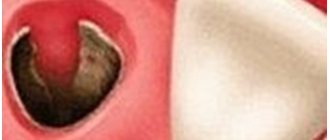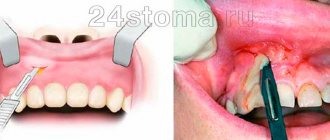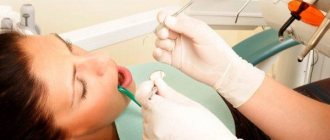From this article you will learn:
- Wisdom tooth removed - how long will it hurt?
- what are the complications?
- How long does it take for gums to heal after wisdom tooth removal?
The article was written by a dental surgeon with more than 19 years of experience.
According to statistics, after the removal of a wisdom tooth, inflammation of the socket of the extracted tooth occurs in 25-30% of cases. For example, after the removal of any other groups of teeth, inflammation occurs only in 3-5% of cases. This is due: firstly, to the higher complexity of removing wisdom teeth, and secondly, to the fact that they are surrounded by a large amount of soft tissue.
The last circumstance is very important, because the presence of moving soft tissues in the area of the extracted tooth socket often leads to the loss of the clot - its loss or even destruction. If the socket of the extracted tooth is not closed by a blood clot, inflammation will inevitably develop in it.
Gums after wisdom tooth removal (normal) –
When wisdom teeth are removed, stitches are almost always required. This is necessary because these teeth are located deep in the soft tissues and in this place the mucous membrane is very mobile. The absence of sutures in this situation can lead to prolapse of the clot and inflammation. But if the patient has a long jaw and there is enough space for the wisdom tooth, the socket will look traditional (Fig. 3).
To learn how the sockets of extracted teeth should normally heal, and how to speed up this process, read the article: “How long should gums take to heal?”
Carrying out the procedure
The tooth extraction procedure is carried out using effective, modern painkillers, so, as a rule, there is no pain during the operation itself.
The operation begins immediately after the anesthesia takes effect. A scalpel is used to loosen the ligament supporting the tooth.
If the procedure was traumatic, or the edges of the wound are too wide, the dental surgeon may use self-absorbing sutures. But most often, the wound is simply closed with a gauze pad with a special hemostatic agent. To stop bleeding, you need to lightly but firmly press the tampon onto the wound with closed jaws. After 20 minutes, the gauze can be spat out.
Main treatment methods
Your dentist will tell you what treatment and gum care should be like after tooth extraction. Only he can select the right drugs that are suitable specifically for your case.
Among the most common treatment methods are the following:
- Careful rinsing with preparations and tinctures with various herbal ingredients and antiseptics.
- Local application of soothing ointments and gels.
- Drug treatment. Your doctor may prescribe antibiotics, painkillers, and anti-inflammatory drugs. But we do not recommend using any medications without a prescription.
Gum condition
Pain in the gums may occur after the anesthetic drug wears off, that is, after 3-4 hours. After the procedure, the patient is often worried about the return of painful sensations and the release of ichor (for 4–6 hours. After the operation, the wound looks quite scary, especially if a wisdom tooth was removed.
In the absence of pathology, the healing process occurs in several stages.
Doctors providing this service
Modern surgical dentistry makes it possible to avoid tooth extraction in most cases, but tooth extraction is still sometimes necessary.
An operation to remove a tooth should be performed only as a last resort, when other methods to save the tooth are no longer possible or when the tooth may cause other, more serious complications.
Indications for tooth extraction
A fairly common indication for tooth extraction is the need to sanitation the oral cavity in the presence of chronic periodontitis in the acute stage, when it is impossible to eliminate the inflammatory focus at the apex of the tooth.
In some cases, tooth extraction is performed to avoid more serious complications. For example, if you have teeth that can cause a cyst, inflammation or neuritis of the trigeminal nerve. If a tooth constantly injures the tongue or the mucous membrane of the cheek, and also interferes with a normal bite, it is also better to remove such a tooth. Multi-rooted teeth, which are the cause of odontogenic osteomyelitis, are removed. When fitting a removable denture, sometimes it becomes necessary to remove teeth, but there must be strict indications for this.
Surgical operations to remove a tooth are performed under effective anesthesia, taking into account all contraindications.
Teeth are removed when they are severely damaged by caries, affected by advanced periodontal disease (“sick gums”), have been broken so that they can no longer be restored, are incorrectly positioned in the mouth (for example, an embedded wisdom tooth), or in preparation for orthodontic treatment.
Before starting tooth extraction, the dentist examines the oral cavity, takes x-rays of diseased teeth, and evaluates their condition.
After a tooth is removed, the teeth adjacent to it begin to gradually shift, sometimes quite significantly, and this can greatly affect the general condition of the teeth. Removing even a single tooth can create serious chewing problems. To avoid these complications, the dentist will recommend replacing the extracted tooth with an artificial one.
Considering all the advances in operative surgery today, most patients prefer to replace the existing dentition defect by placing a dental implant (advantages of using dental implants), dental bridges or removable partial dentures.
Wisdom teeth removal
The removal of wisdom teeth is due to slightly different reasons. Naturally, the above reasons for tooth removal also apply to the removal of wisdom teeth, however, this case has its own characteristics.
Problems with wisdom teeth often arise as soon as they erupt. They erupt at the age of 18-25 years (sometimes much later), when the dentition is formed by 28 teeth, which leads to incorrect placement of wisdom teeth in the dentition (the lower wisdom teeth are more often displaced), immersion (incomplete eruption with a tilt in the vertical, horizontal, distal or medial direction). In addition, misaligned wisdom teeth can cause damage to adjacent teeth, putting pressure on them and causing root damage and resorption, as well as displacement and malocclusion.
There are no dental rules determining the most acceptable age for wisdom tooth removal. However, practice shows that the sooner you get rid of these teeth, the fewer complications you can expect from them in the future.
If the wisdom tooth is in the wrong position or has not fully erupted, this leads to pericoronitis (inflammation of the tissues surrounding the tooth), because Part of the tooth is located under the gum and food debris accumulates in the gum pocket, which is an excellent breeding ground for various microorganisms. Wisdom teeth are often affected by caries, because... Between it and the second molar, food debris also accumulates and plaque forms due to the fact that this space is difficult to clean with a toothbrush. In this case, caries affects not only the wisdom tooth, but also the second molar adjacent to it.
- refrain from eating for 2-3 hours after removal;
- do not drink alcohol or take a sauna on the day of surgery;
- do not touch the hole with your tongue or any objects;
- do not eat hot food;
- do not rinse your mouth.
Day after the procedure
At the initial stage, the hole remaining in the place of the pulled out tooth is filled with a scarlet blood clot. It is not recommended to remove it, as it performs several functions:
- protects the wound from infections;
- eliminates bleeding from blood vessels;
- promotes the formation of new tissue that will fill the empty space.
To avoid breaking up the blood clot, it is recommended not to brush your teeth on the day of surgery. Smoking is accompanied by inhalation of smoke, which creates negative pressure in the oral cavity. This may help pull the clot out of the socket. It is not recommended to blow your nose or spit. Rinsing your mouth should also be avoided; you can simply put the solution in your mouth and hold it for a while without rinsing. Gentle rinsing can be indicated only in the presence of inflammatory and purulent processes.
How to remove a tooth
There are two extraction methods used in dentistry: simple and complex. Their choice depends on which teeth are being removed - premolars and molars with tangled branched roots are removed using a complex method. It is very difficult to pull out such elements entirely due to the fact that the tooth socket is penetrated by retaining ligaments and alveolar processes. Errors during the procedure or insufficient experience of the specialist lead to serious complications. Therefore, even despite the acute condition, always find out in advance where you can have a tooth removed from a good doctor with positive recommendations.
Factors complicating the operation:
- complete destruction of the coronal part;
- high fragility;
- acute inflammatory diseases;
- Unerupted or misaligned wisdom teeth.
The technology of the procedure depends on which teeth are removed. In some cases, tissue incision and suturing are performed.
After three days
The blood clot begins to change and thicken. Gray and white fibrin stripes appear on it, after which the formation of new gum tissue begins. Painful sensations may still occur. But they are much weaker and have a pulling character. The patient may experience bad breath. This is considered normal and is due to the formation of a blood clot. Failure to brush your teeth also leads to the formation of bacteria and an unpleasant odor.
To rinse the mouth, you must use special solutions recommended by your doctor. The appearance of pain from touching the gums, increased pain during eating, serves as a signal for the need to return to the dentist's office. If the tissue of the edges of the hole has acquired a red tint, you should also immediately consult a specialist.
Normal and pathological signs
What should the wound look like after extraction? It is necessary to consider which symptoms are normal and which are pathological. Normally, on day 3, the wound is covered with a white film, which signals the healing process. By 4-5 days the entire hole becomes light. If a coating of any other color forms on the surface of the wound, and an unpleasant odor emanates from the mouth, you should immediately consult a doctor. The sign indicates that an infectious process has begun.
Photo of the hole after removal
A normal reaction of the body after extraction is inflammation and swelling of the gums. The signs are due to the fact that during the intervention, damage to soft tissues, blood vessels and nerve endings occurs. Pain after surgery is also normal, but only if it lasts no more than 5-7 days. After removal of sixes, sevens or wisdom teeth, an unpleasant sign radiates to the ears and joints. In the latter case, it becomes difficult for a person to chew. All of these symptoms are normal and usually do not get worse over time. Dentists recommend taking painkillers for 5 days to avoid discomfort.
Bruise on the cheek after tooth extraction
Pathological signs of socket healing after tooth extraction:
- increased pain;
- pulsating nature of pain;
- temperature increase;
- inflammation of the lymph nodes;
- aching sensations in the area of neighboring elements, manifesting itself for more than 2-3 hours;
- rise in temperature;
- signs of intoxication of the body;
- the hole does not overgrow.
An alarming sign after the intervention is the appearance of severe swelling of the cheeks and gums in the first few hours. To reduce the intensity of the symptom, you can apply a cold compress to the problematic side. If the inflammation intensifies or spreads to the chin and neck, you should immediately consult a doctor or call an ambulance. The symptom indicates the rapid progression of an infectious complication.
Photo of a swollen cheek after tooth extraction in the socket
A physiologically normal symptom after tooth extraction is bleeding for several hours. The intensity of bleeding varies for several hours after the intervention. Heavy discharge is observed within 15-30 minutes, after this time the symptom should appear less intensely. The bleeding stops completely after 2 hours.
If the bleeding does not stop, then it is necessary to apply a gauze swab moistened with an antiseptic solution to the damaged area. A doctor is consulted when the performed manipulations do not produce results. An additional symptom that is a reason to consult a doctor is a temperature above 38 degrees.
After 2–3 months and beyond
The gum gradually hardens, and the space remaining from the tooth is filled with maturing bone tissue. By the beginning of the 4th month, the gum bone tissue completes its formation. The gum can be called completely healed.
If the wound heals with suppuration, then healing of the wound can last up to six months.
Sinusitis, maxillary sinus cyst, loss of sense of smell after visiting the dentist
The roots of the teeth of the upper jaw can normally be adjacent to the maxillary (maxillary) sinuses of the nose and even survive in them . Sinusitis, maxillary sinus cyst and loss of smell are possible when infection or filling material penetrates from the teeth into the paranasal sinuses. Unfortunately, this is not uncommon. Moreover, some cases of persistently recurrent sinusitis are associated with infection penetrating from the roots of the teeth . In this case, a possible symptom is a strong unpleasant odor from the nose and mouth.
Odontogenic sinusitis after treatment by a dentist
Odontogenic sinusitis (scheme). Teeth and maxillary sinus. On the left is the norm. On the right – the root of the “seven” (tooth 2_7) is destroyed, inflammation around the destroyed root, pus in the maxillary sinus.
Filling material in the maxillary sinus and sinusitis after filling the “six” canals (tooth 2_6). Pain in the left side of the face after visiting the dentist.
1 – roots of teeth, 2 – normal, air in the right maxillary sinus (front view, the air looks black in the picture), 3 – in the left maxillary sinus there is a fragment of filling material surrounded by an inflammatory shaft. The patient had been mistakenly receiving treatment for trigeminal neuralgia for a long time.
Cysts of the maxillary (maxillary) sinuses in diseases of the roots of the teeth.
1 – roots of the teeth, 2 – cysts of the maxillary sinuses, growing from the roots of the teeth (cysts are round “bubbles”, they look gray in the picture).
How can we help you:
- Let's find the source of pain after dental treatment;
- We will treat inflammatory processes, sinusitis, sinusitis and neurological complications; if necessary, your health will be taken care of jointly by a neurologist and an ENT doctor. Treatment of sinusitis without puncture
Gum healing process
The speed of gum healing depends on several factors:
- individual characteristics of the patient’s immunity;
- the success of the operation;
- location of the extracted tooth.
If the tooth is in a hard-to-reach place, has crooked roots, or its crown has been significantly damaged, then the removal procedure becomes more complicated. During manipulation, the tooth may begin to crumble, leaving fragments in the gum. In this case, it is necessary to cut the gum tissue, detach it from the bone, remove the tooth in parts, and use a drill. These traumatic procedures prolong the period of gum healing after surgery.
Slight swelling of the gums is considered normal. The temperature may rise slightly (due to an immune reaction). The swelling usually subsides within three days.
Noticeable swelling of the gum is also observed after cutting it. This swelling goes away in about one week.
Reasons for long gum healing
Typically, the answer to the question of why gums take a long time to heal is related to the individual characteristics of the human body, as well as infection.
The addition of a secondary infection can be observed against the background of several common problems:
- The patient violated the requirements for proper gum care. Often the problem lies in the fact that too much caution has been exercised and the quality of oral hygiene has decreased.
- The wound was not properly cleaned. When patients turn to dentists with a low level of skills, there is a high probability that a tooth fragment or a piece of cotton wool will remain in the hole. This can cause serious problems and greatly increase the duration of the recovery process.
- An injury occurred. It is worth watching exactly how you handle the hole. So doctors recommend avoiding any friction, strong pressure and other mechanical irritations.
Any dentist will tell you that removal is best done when the person is completely healthy. Regeneration time may increase if there are diseases of the oral cavity, stomatitis. You should also be wary of sinusitis and sore throat - they can complicate the recovery process.
Possible complications
Signs of alarm should be considered an enlargement of the cheek, further spread of swelling, a persistent increase in temperature, increased pain, nausea, and weakness. If the healing process is disrupted, the following complications may occur:
- Cyst formation. It is a fibrous neoplasm filled with fluid.
- Flux. Formed after infection penetrates into the socket and then into the periosteum. The resulting inflammation is characterized by severe swelling of the cheek on the side of the diseased gum. There is severe pain and redness of the gums. The formation of flux requires immediate medical attention. Therefore, it is necessary to carefully protect the site of the extracted tooth from possible infection.
- Alveolitis. This is a complication that occurs during the inflammatory process of the hole in the jaw bone. The infection occurs due to a violation of the integrity of the protective blood clot. The onset of the disease is characterized by inflammation of the outer layers of the socket, spreading into the deep layers of the bone. Alveolitis is accompanied by aching pain during eating, swelling and redness of the gums. There is a putrid odor from the mouth. The patient feels chills, headache, and fever. The occurrence of the disease most often occurs during the extraction of molars located on the lower jaw. It is necessary to obtain medical attention in a timely manner to avoid the spread of infection to other organs. One of the dangerous complications of the disease is osteomyelitis.
Removing wisdom teeth is a more complex procedure, so gum inflammation often occurs after surgery. At the same time, discoloration or swelling of the gums should not cause concern to the patient. Often after surgery there are difficulties opening and closing the mouth. This is a consequence of surgery. To get to a hard-to-reach place, the doctor asks the patient to open his mouth as wide as possible. The pressure exerted on the tissues leads to their swelling. On the 3rd day, the discomfort usually goes away completely. The appearance of purulent contents in the hole, increased temperature, acute pain, heavy bleeding - all these signs require immediate contact with the dentist.
How does the regeneration process proceed after extraction of the “eight”
The socket of an extracted wisdom tooth is always deep. This is due to the structural features of the “eights” - they have tortuous and long roots, which cannot be extracted from the gum tissue atraumatically. Blood flows from the wound for some time. This is due to the rupture of local microvessels. Then she curls up. Then a dense blood clot forms. It is needed to protect tissues from infection.
After the operation, the doctor applies a sterile gauze swab to the hole. To fix it, the patient must close his jaws. This helps stop bleeding as quickly as possible. You need to keep the tampon in place for as long as your doctor tells you. Under no circumstances should you spit it out at the first opportunity.
In the first two days, the clot filling the hole has a rich burgundy color. Under no circumstances should you touch it, let alone try to remove it. It serves as a barrier that prevents germs, bacteria and food debris from entering an unhealed wound.
Starting from the second or third day, the appearance of the clot changes. A light coating forms on its surface. Many people get scared because they think they are releasing pus. There is no need to worry - this is a normal process. The change in the shade of the socket is associated with the formation of new protective epithelial tissue, the basis of which is fibrin protein.
Gradually, the clot dissolves on its own and disappears. A healthy pink mucous membrane is found underneath. This indicates that regeneration was completed successfully.
Recommendations after tooth extraction
There are recommendations that, if followed, significantly speed up the gum healing process. Not only the speed of wound healing depends on them, but also the absence of possible complications. The doctor’s main recommendations in the postoperative period may be the following:
- you need to avoid foods that are too hot, spicy, or irritating to gum tissue;
- in the first days you need to carefully avoid damaging the clot; It is necessary to be extremely careful in maintaining oral hygiene;
- about 3 hours after the tooth extraction procedure you need to refrain from eating;
- in the next three days you need to eat only soft food, without consuming sweets, alcohol, or hot drinks;
- on the first day after the procedure, it is recommended to sleep on a high pillow;
- During the week, it is recommended to avoid visiting the sauna, solarium, sunbathing on the beach, and reduce physical activity;
- on the first day, it is forbidden to brush your teeth to avoid damaging the blood clot;
- Do not try to pick the clot with your finger, toothpick or tongue;
- a cold compress should be applied to the surgical area for 20 minutes, every 2 hours;
- It is recommended to use oral baths and then rinse with antiseptic agents.
The postoperative period requires careful attention to the patient's health status. A complication resulting from neglect of the rules will require much more time, money and effort to heal the wound.
How to properly care for your gums
To prevent complications from occurring, you should follow a few simple recommendations:
- Do not heat the gum. Strong heat can stimulate the spread of the inflammatory process.
- Use a soft brush. At the same time, when brushing your teeth, try not to touch the gums at the extraction site.
- Use additional cleaning products. These include irrigators and dental floss.
- Try to use toothpastes with soothing herbal ingredients.
It is very important not to self-medicate. If any problem arises, you should consult a doctor as soon as possible.
help yourself
Typically, surgeons do not recommend doing anything with the wound that remains after tooth extraction. But pain does not have to be endured, especially for people who have a low pain threshold. There is a whole arsenal of remedies, from official medications to folk remedies, that can reduce pain and alleviate the plight of a patient who has lost a tooth.
- How long does it take for drugs to leave the body?
Table. Medicines to relieve pain after tooth extraction
| A drug | Action |
| Ketorolac (and analogues with identical active ingredients) | The drug is potent. The pain is relieved within 20 minutes. Moreover, it copes even with severe pain. Lasts effect for 6 hours. Can be taken up to 4 times a day. |
| Nimesulide | Refers to super potent drugs. The pain goes away within a quarter of an hour. This drug should not be abused. |
| Analgin | It is not considered a serious anabolic that helps with toothache, but it successfully relieves pain of mild to moderate severity. |
| Baralgin | Even softer and weaker in action than analgin. Effective only for mild and non-intense pain. |
| Spasmalgon | It has rather weak anabolic properties, but at the same time has an anti-inflammatory effect, so it is preferred for moderate and mild pain to analgin and baralgin. |
Each person is used to dealing with pain using their own methods. For some, only a group of ketorolac helps, while others are completely satisfied with baralgin. And for some people it is not necessary to take potent drugs with a lot of side effects - simple folk remedies are enough.
People's Arsenal
The simplest, most harmless and effective remedy, it can be used by everyone without exception to relieve post-operative toothache - a cold compress . Effective in the first day after removal. In many private clinics, the patient is sent home after surgery with an ice bag applied to the cheek. At home, it is good to use ice in which just water or a decoction of medicinal herbs is frozen. Any item from the freezer will do, such as a piece of frozen meat. Just wet the towels with cold water, apply them and change them as soon as they reach body temperature. There is a cooling patch in the pharmacy that has the same effect as a compress - it freezes the nerve endings and relieves pain.
Cold compress
Important! Rinses during tooth extraction can be used only after three days after the operation. And then these should not be rinses, but rather baths. Take a herbal decoction or saline solution into your mouth, hold it without unnecessary movements of the liquid, and spit it out. All this is to quickly relieve inflammation, but not to move or wash away the blood clot.
A remedy that will not cause harm, but only benefit, is propolis. It has strong antibacterial properties, therefore, to normalize and disinfect the microflora in the mouth, it is recommended to hold a piece of propolis in the socket of an extracted tooth.
Propolis
How long does it take for a dry socket to heal?
Many people are interested in the question of how long it takes for a dry socket to heal. In the absence of complications, the wound heals in 5 - 7 days, and within a month the hole is filled with epithelial tissue. If you have dry socket, the healing process may take longer than two weeks (with proper treatment, of course). As already mentioned, extensive inflammation may occur and even require surgical hospitalization of the patient: in this case, the healing of the dry socket may be very delayed.











